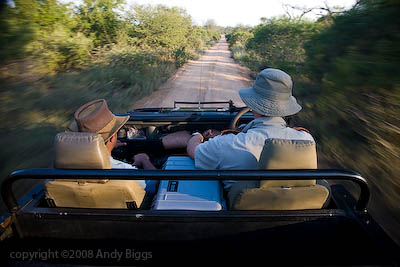I have been working on putting this very unique safari together for quite some time, and now I am glad to announce this amazing photographic safari. We will be visiting the three absolute best photographic locations in east Africa, in the country of Tanzania. We will visit three stunning wildlife locations on this safari: the World Heritage Site of Ngorongoro Crater and its high density of predators, the wide open plains of the Serengeti, and to top it all off we will be hiking and tracking wild chimpanzees in Mahale Mountains National Park.
As you may know, I spend quite a bit of time in Tanzania each year, mostly in the northern part of the country. It is not often that I am able to logistically pull off a trip like this, and I am extremely excited and look forward to this safari in October 2009. The safari is a perfect safari for returning travelers, as well as for a first time safari.
Trip Highlights:
October 16-31, 2009
Trip leader: Andy Biggs
Locations visited and what makes each location unique:
Ngorongoro Crater for its high density of predators, as well as high amount of grazers, browsers and birds of prey
Serengeti National Park for its 3 million wildebeest, 400,000 zebra, wide open plains and tons of big cats!
Mahale Mountains National Park for its wild chimpanzees, remoteness and extremely comfortable lodging in a beautiful setting on lake Tanganyika
Please be aware that hiking with the wild chimpanzees requires a reasonable level of fitness.
Cost: $14,990
I have put a teaser on my web site for a few months now, and I will be sending out an announcement shortly. I anticipate that this safari will not stay open for too terribly long. If you have a measurable interest, please contact me at info@andybiggs.com or use the contact form on the left hand side of this web page.
Additional information regarding Mahale Mountains and hiking with wild chimpanzees
Tracking chimps in the Mahale Mountains may be one of the most rewarding experiences of your life. To fully benefit from the
experience you must start with the correct expectations and be prepared for the physical rigors of such a trip. Feel free to ask us if you have
any questions.
The Accommodation The camp feels like a tropical paradise, natural enough to be unobtrusive and substantial enough to be comfortable. It is a castaway style retreat with unique, airy, wood-and-thatch cabins, comfortable furnishings, and private flush toilet and hot shower facilities at the back of each cabin. Lighting is provided by solar power, and there is also a generator in camp. The food is fresh, simple, and skillfully prepared. Reasonable dietary requests can be accommodated, but advanced notice is a must.
Chimp Tracking – Physical Considerations The camp is located on the lake shore at 2700 ft. elevation. The forested mountains rise behind the camp to 8000 ft. The chimps in the area have a range of 30 sq. km. (almost 12 sq. miles) - from the lake shore to the top of the mountains. Determining where they will be on any given day depends on an unpredictable variety of factors. It is entirely normal to find them behind camp in the afternoon of one day and on an inaccessible ridge high up in the mountains by the next morning. Most guests see the chimps at least once in a 3 or 4 day stay.
People who are in good shape for hiking up and down steep hills will have the best chance of being able to see the chimps. Every effort will be made to accommodate those who are moving more slowly, but typically it is not possible for the group to split up if one person becomes tired. The whole group will have to turn around, or find less steep paths. It can take anywhere from 15 minutes to 5 hours of hiking to find the chimps. The chimps often use the groomed paths, but it is just as likely that they will be crashing through the underbrush over uneven ground. Trackers must be prepared for all hiking conditions. Walking sticks are available at the camp, but you need to bring a good light-weight pair of hiking boots that provide plenty of traction – preferably with ankle support.
 Wednesday, July 16, 2008 at 05:00PM
Wednesday, July 16, 2008 at 05:00PM 






